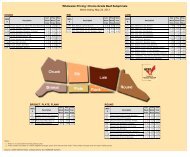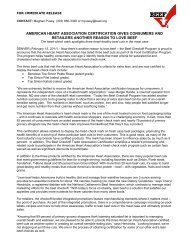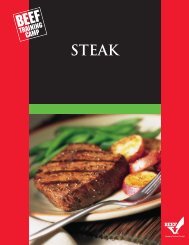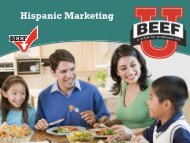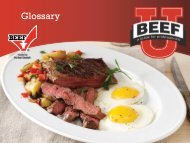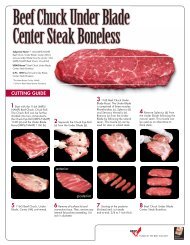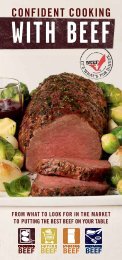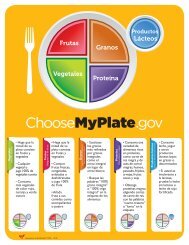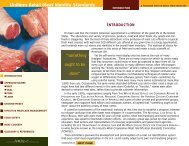Fact Sheet - Beef Foodservice
Fact Sheet - Beef Foodservice
Fact Sheet - Beef Foodservice
Create successful ePaper yourself
Turn your PDF publications into a flip-book with our unique Google optimized e-Paper software.
Fat thickness over the Ribeye and percent of kidney, pelvic and heart fat are indicators<br />
of total carcass fatness. As these measurements increase, the yield grade number<br />
increases (moves closer to Yield Grade 5), and the carcass becomes less desirable.<br />
The Ribeye area is an indicator of carcass muscularity. As the Ribeye area increases,<br />
the numerical yield grade decreases (moves closer to Yield Grade 1) and the carcass<br />
becomes more desirable.<br />
Although USDA has developed a formula for calculating the yield grade, as a practical<br />
matter the grader relies upon his or her experience and training to make this<br />
determination. However, the grader may check using the formula occasionally when<br />
requested to do so. The same process holds true for the USDA grader when determining<br />
the USDA Quality Grade.<br />
USDA Yield Grades are “rolled” onto the beef carcass at the same time as the USDA<br />
Quality Grade. However, the Yield Grade number placed on the carcass is “rounded<br />
down” in all cases by dropping any decimal. Therefore, a calculated Yield Grade of “3.1”<br />
for one carcass and one of “3.8” for another would result in both carcasses being rolled<br />
as “USDA Yield Grade 3” for marketing purposes.<br />
Certification<br />
Although “branding” is an increasingly popular concept in merchandising beef today, it is<br />
certainly not a new concept. Decades ago, recognized brands were commonplace, and<br />
names such as “Swift Premium” and “Armour Star” reflected a certain level of quality that<br />
was both understood and trusted by most consumers.<br />
In today’s increasingly competitive marketplace, however, it is difficult for beef marketers<br />
with less recognizable names to introduce branded products that will instill immediate<br />
customer confidence. However, by structuring such programs to include elements of<br />
federal programs that are both recognized and trusted by customers, the opportunity for<br />
success is enhanced.<br />
The Agricultural Marketing Service (AMS) of the U.S. Department of Agriculture (USDA)<br />
provides voluntary certification services to assist in the marketing of branded beef<br />
programs. This service provides for certification of specific carcass characteristics that<br />
are contained within each program’s published requirements. This AMS certification<br />
provides confidence throughout the marketing chain that the claims made were<br />
substantiated by independent third party oversight. AMS currently has approved<br />
certification services for over 40 beef programs, with each beef certification program<br />
varying in the level of claims for “quality.”<br />
The descriptions of these certified beef programs are available for review to determine if<br />
one or more meets specific needs with the confidence that the USDA has certified the<br />
claims made in each program.



